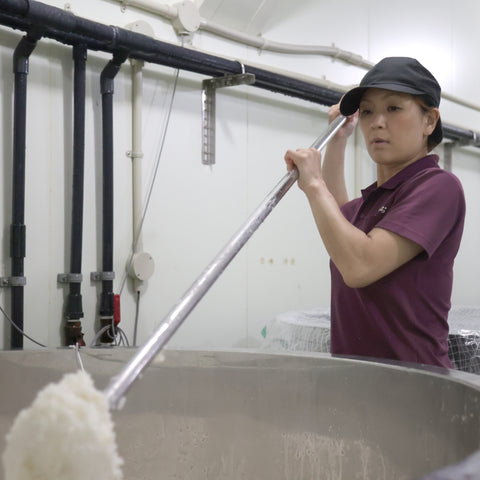
Sake Gumi is our monthly sake subscription service with 200 members throughout the country. Join today!
People often ask me if rice strains have the same effect on sake as the grape varietals have on wine. My answer is yes and no. Yes, because different rice strains are ideal for growing in specific regions and can result in certain qualities in the finished sake. But also no; there are so many other factors that can have an effect on the result, such as rice polishing (which can affect how light or full-bodied a sake is) or the yeast used (which can determine its aroma). However, it’s still worth talking about rice strains, because many brewers take pride in using rice that is grown locally or go to great lengths to use a specific rice to achieve the profiles they want.
The two most commonly used sake rice strains are Yamada Nishiki (featured in the Gumi way back in August 2016) and Gohyakumangoku. This month, I am introducing sakes made with Miyama Nishiki, the third most commonly used rice strain for sake making in Japan. I wanted to highlight this rice because I love its resulting crisp and refreshing sakes.
The master brewer at Daisekkei Sake Brewery, Mamoru Nagase explains, “Miyama Nishiki has a hard rice quality that makes it difficult to dissolve in the moromi (fermentation mash). As a result, sake tends to have a clean, light taste and sharpness.” Toshihito Watari, the president of Watari Honten adds, “Another major feature is the moderate bitterness. Therefore, by aging it, you can enjoy the change in taste that becomes mellow.”
Miyama means “beautiful mountain” evoking the snow-capped mountains of Nagano, where the rice strain was born. Nishiki means “brocade” and is often used in reference to rice. Miyama Nishiki was introduced in 1978, and is a mutated version of Takane Nishiki. It can tolerate very cold temperatures and thrives in regions like Nagano and the Tohoku region. It is therefore no coincidence that the sakes featured this month come from Nagano, Akita, and Yamagata Prefectures, all known for their bitterly cold winters.
Kanpai,
-Yoko (Sake Director and Co-Founder, Umami Mart)
LEVEL 1

Daisekkei Junmai Ginjo
Daisekkei Sake Brewery (Nagano, Japan)
Seimaibuai: Miyama Nishiki 55%, SMV: 2, Yeast: 1001 + 1801, Acidity: 1.6
This is a perfect example of a refreshing sake brewed with Miyama Nishiki. Balancing light lychee and lemon aromas with crisp acidity, this is a crushable ginjo. Master Brewer Mamoru Nagase describes the locality of this sake, “Azumino, where we are located, is famous for its pristine water and is the number one wasabi producer. All of the sake rice used at Daisekkei Sake Brewery is locally grown in Azumino.” Try this sake chilled or at room temperature with dishes that are prepared simply, such as greek salad or steak with wasabi salt.

Dewanoyuki Yuki Kimoto Junmai
Watarai Honten (Yamagata, Japan)
Seimaibuai: Miyama Nishiki 60% (Kojimai), Dewa Kirari or Haenuki 65% (Kakemai), SMV: 1.5, Yeast: NF-KA, Acidity: 1.8
In addition to using the kimoto technique, which is a longer starter method that enables naturally occurring lactic acid, the brewers age this sake for up to 11 months to mellow out the sharpness of the Miyama Nishiki. This results in a sake that President Toshihito Watarai says, “is akin to a full-bodied red wine-type alcohol that pairs perfectly with food.” In fact, the higher acidity which drinks dry with a sharpness of cedar was great with lasagna or soppressata. Try at room temperature in a wine glass or warm in a ceramic cup to get aromas of candied pecan and creme brulee. When asked why they used Miyama Nishiki for this sake, Watarai simply says, “Miyama Nishiki was originally the most easily available rice suitable for sake brewing in Yamagata Prefecture.”

Chokaisan “Mt Chokai Nama” Junmai Daiginjo Nama Genshu
Tenju Shuzo (Akita, Japan)
Seimaibuai: Miyama Nishiki 50%, SMV: +1, Yeast: ND4, Acidity: 1.5
Tenju Shuzo, takes pride in their rice. So much that in 1983, they established the Tenju Sake Rice Study Group, proclaiming, “sake production begins with rice cultivation.” Their mission is to create the best sake rice suitable for their climate. When asked why they use Miyama Nishiki, Managing Director Hitoshi Oi said, “It is compatible with local weather conditions, we have the best understanding of its properties and have confidence in it.” Brewed using ‘Flower Yeast ND4’ which is harvested from nadeshiko flowers, this sake has aromas of strawberry, with notes of creme fraiche, and a crisp, peppery finish reminiscent of burnt caramel. Try this sake chilled with smoked salmon, or parmesan crisps.

Arabashiri “First Wave” Tokubetsu Junmai Nama Genshu
Azumanofumoto Sake Brewery (Yamagata, Japan)
Seimaibuai: Miyama Nishiki 60%, SMV: 0, Yeast: K1801 + K901, Acidity: 1.6
Eiichi Shindo of the brewery says, “Arabashiri is a sake brewing term that refers to the first liquor that comes out of the pressing machine. It expresses the wildness and roughness of the first drink that comes out.” Indeed, this sake hits you like a maverick wave... of fruit and minerals! It’s got aromas of lemon and slate with a full-bodied texture that opens up with time yet finishes crisp. Although this sake does not symbolize the textbook Miyama Nishiki sake, Shindo explains why they use Miyama Nishiki, “It is a hard rice that does not dissolve easily. Moreover, it does not easily deteriorate when stored.” Store and drink chilled alongside a wintry feast like shabu shabu or grilled crab.




Comments (0)
There are no comments for this article. Be the first one to leave a message!